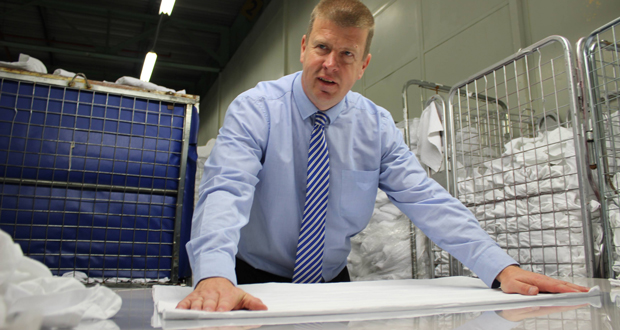Fake tanners and heavy make-up users are costing UK hotels and holiday lets up to £1.792m per year by leaving marks on bedding on towels, according to new figures from linen recovery specialists Regenex.
Laundries all over the country are now condemning an estimated 224 tons of sheets, pillowcases, duvet covers, and towels each year, due to fake tan, self-tan or heavy make-up* — at a huge cost to the environment as well as company finances.
The popularity of sunless tanning has risen dramatically in the past 15 years. Coupled with the current trend for heavy, contoured make-up, this 2020s beauty essential has become the scourge of hotel housekeepers.
Regenex, which uses advanced colour chemistry techniques to restore stained linens for many large UK laundry groups, has calculated that up to a fifth of material arriving for processing has dreaded fake tan streaks.
Though recipes vary, stubborn staining is caused by heavy concentrations of dye reacting with alcohols and mineral oils in the product, rubbing off tanned skin, to leave marks that fix fast to cottons — especially during sweaty summer nights.
However, advances in technology mean snowy white linens can now be restored to pristine condition thanks to clever cleaning techniques involving opening up fibres to release discolouration.
Regenex’s Technical Director, Paul Hamilton, a chartered colourist, and his team, have pioneered new, patented methods in removing this complex stain. Further research and refinement continues.
Hamilton said: “I talk to many long-suffering laundry owners and managers on my travels. They tell me that fake tan and make-up are the stains they dread the most.
“I heard a story about one hotel that hosted a bodybuilding competition recently, and had to throw away three full cages of linen afterwards. This leads us to wonder, should fake tanners pay extra if they mark the linen in their rooms?”
He says the chemistry in products that combines to create a ‘dyeing system’ for human skin also works effectively to colour sheets and towels.
Hamilton continued: “There’s also a trend among social media beauty influencers to wipe off heavy make-up using towels and facecloths, and this too is leading to more stained and discoloured items than ever before, as people emulate such routines.
“Margins for the hospitality industry are tight – and hoteliers must recoup such losses where they can. Maybe it is time for them to say enough is enough and impose charges?”
Processing costs for stained linen are typically 30 per cent of the price of buying new items. Opting to revive linen and return it to stock, rather than sending to landfill or rag, has the important benefit of helping laundries to lower their carbon footprints, and cut down on unnecessary manufacturing.
Hamilton added: “Our research indicates that machine washing linens in the usual way, especially more than once, can fix fake tan stains further. My advice is to seek specialist cleaning as soon as possible to give those towels and sheets the best chance of survival.”
Regenex also offers dyeing services, and has seen an upturn in requests to revitalise tan-stained white towels with rich shades for spa-type use.
* How the cost of fake tan to hospitality is calculated
The Textile Services Association estimates 2,000 tonnes of linen is discarded every year and 56 per cent of all linen in commercial laundry systems is from the hospitality industry. This indicates that 224 tonnes of the 1,120 tonnes binned by hotels and holiday lets are marked with fake tan.
As new, good quality hospitality linen typically costs £8 per kilo that’s a cost to the industry of £1.792 million – the volume equivalent of 200,000 sheets.





